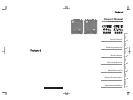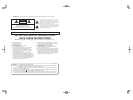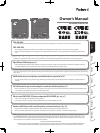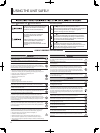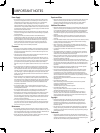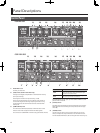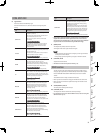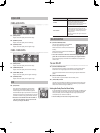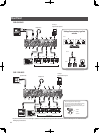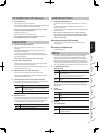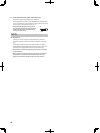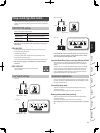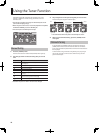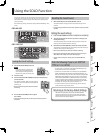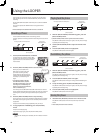
5
Português Italiano DeutschNederlands Español Français
English
COSM AMPLIFIER
6. Type Switch
Use this to select the COSM amp type.
If the Tuner function is on, use this to select the string that you’re
tuning.
Type Description
SUPER FLAT
An original amp featuring a wide-range
frequency response.
This amp type provides faithful reproduction of
the connected bass’s own sound.
This is a great type for all kinds of connected
instrument.
[SHAPE] Switch: ON
This produces a mild tone with a fat midrange,
providing a sound that is perfect for fretless
basses, including fretless electric and wood
acoustic basses.
FLIP TOP
Models the Ampeg B-15 (1 x 15”). This amp
provided the underpinning for many of the most
famous Motown hits.
It features a fat sound, while the amp’s compact
cabinet produces a distinct contour.
[SHAPE] Switch: ON
O ers more nuances of your picking expression.
B MAN
Models the Fender Bassman 100 (4 x 12”).
This amp has been a favorite since the
inception of electric basses. It features the sonic
characteristics of tube amps, whereby increasing
the distortion slightly yields a fatter sound.
[SHAPE] Switch: ON
O ers a tone with boosted midrange fatness.
T.E
Models the Trace Elliot AH600SMX + 1048 (4 x
10") + 1518 (1 x 15"). This amp was used widely
by rock bands in the 1980s. Its wide range, clear
attack, and other features make it a great amp for
all kinds of performance situations.
[SHAPE] Switch: ON
O ers more attack.
BASS360
Models the acoustic 360 (1 x 18”).
This amp was used in the ’70s not only by jazz
bassists, but by funk and hard rock players as
well. The tone features a warm low end with a
midrange that maintains a clear contour, even
with nger picking.
[SHAPE] Switch: ON
O ers more nuances of your picking expression.
SESSION
Models the SWR SM-400 + Goliath (4 x 10”) +
Big Ben (1 x 18”). This tweeter-equipped amp
is representative of the “L.A. Sound” of the ’80s.
It features a wide-range tone that balances
presence in the low end with a clear, open sound.
[SHAPE] Switch: ON
O ers a tight tone with a cut midrange.
CONCERT 810
Models the Ampeg SVT + 810E (8 x 10”).
This amp typi es the rock sound that relied
heavily on combinations of high-output tube
amp sections and large-sized cabinets.
The characteristic sound is one of overwhelming
low-frequency sound pressure.
[SHAPE] Switch: ON
O ers extra heavy bottom sound.
Type Description
SUPER LOW
In addition to the wide-range frequency response
that SUPER FLAT o ers, this original amp also
provides for the reproduction of heavy, deeply
resounding bass sounds.
While faithfully reproducing the inherent sound
of the bass you’ve connected, this also provides
for deeply resounding bass sounds. Additionally,
it o ers a suffi cient amount of clarity, so sounds
don’t get buried by the low-frequency content.
[SHAPE] Switch: ON
The well-de ned heavy bass sounds are boosted.
* The product names mentioned in this document are trademarks or
registered trademarks of their respective owners. In this manual,
these names are used because it is the most practical way of describ-
ing the sounds that are simulated using COSM technology.
7. [GAIN] Knob
This adjusts the preamp section’s input level.
Turning the knob to the right increases the gain.
HINT
• Adjust the knob until the value is as high as you can get it without
causing the sound to distort.
• Using a high gain setting allows you to get an overdrive sound.
8. [VOLUME] Knob
Adjusts the overall volume.
* This does not work with respect to DI OUT (p. 9).
SOLO Function
This lets you save the panel settings for sounds you create (such as
amp type, gain, equalizer, and various e ects) and call them up later.
On the CUBE-60XL BASS/CUBE-120XL BASS, this function is called
“SOLO.”
The SOLO function is handy in situations like these:
• When you want to switch the amp type and e ect at the same time.
• When you want to switch the equalizer settings and volume level at
the same time.
9. SOLO [ON/OFF] Switch
This saves panel settings and calls up it.
10. [VOLUME] Knob
This adjusts the volume level for the called-up settings.
* For information on how to use the SOLO function, refer to “Using the
SOLO Function” (p. 13).



